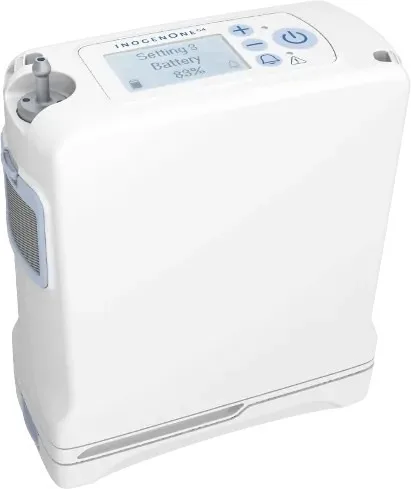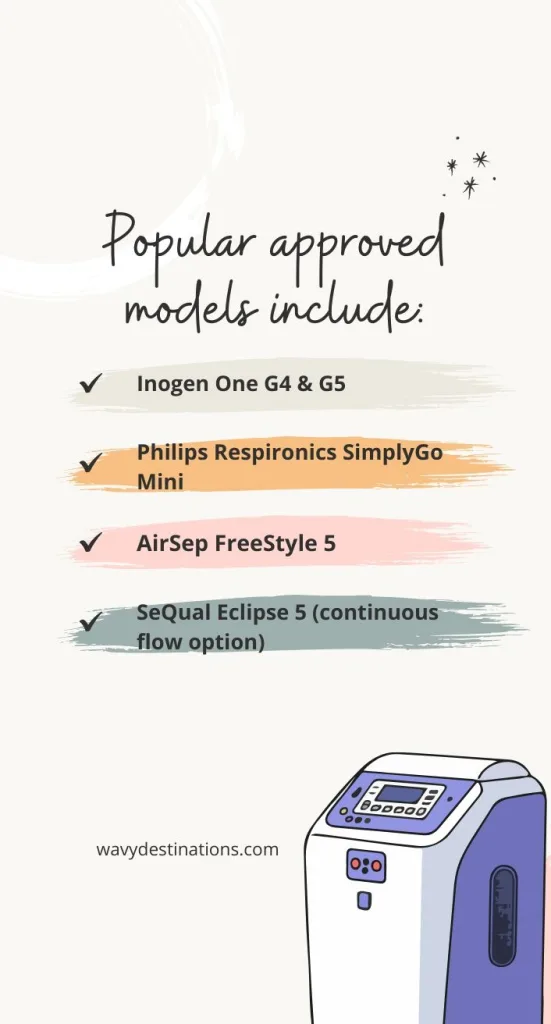Portable Oxygen Concentrator for Travel 2025: FAA Approved, Medicare Coverage & Best Models
Traveling while managing oxygen therapy once felt like an impossible dream until I discovered the freedom of using a Portable Oxygen Concentrator for Travel.
The first time I carried mine on a trip, I was amazed at how effortless it made everything from airport check-ins to long flights and scenic road adventures.
No more worrying about refills or restrictions just pure independence. Whether you’re exploring new destinations, visiting loved ones, or simply enjoying a day outdoors, a portable oxygen concentrator ensures you can breathe comfortably wherever life takes you. Here’s my complete experience and guide to traveling confidently with one.

Understanding Oxygen Concentrators
Before I started my oxygen therapy journey, I had no idea there were so many types of concentrators. Here’s what I learned:
1. Stationary Oxygen Concentrators
These are designed for home use. They’re larger, powerful, and can deliver continuous oxygen flow, perfect for those who spend most of their time indoors. However, they’re not built for travel and usually weigh between 30–55 pounds, often with wheels for easy movement around the house.
2. Portable Oxygen Concentrators (POCs)
These are the real game-changers for travelers like me. Portable oxygen concentrators are lightweight, battery-operated, and ideal for use on the go. Most models weigh between 3–20 pounds, making them easy to carry in a backpack or small travel bag.
While they may not deliver as high an oxygen output as stationary units, they’re designed for convenience, freedom, and independence.
Why I Chose a Portable Oxygen Concentrator for Travel?
The first time I took a trip using my portable oxygen concentrator for airplane travel, I realized how much it simplified life. Instead of worrying about oxygen tanks or refills, I had unlimited oxygen right by my side.
Here’s why a POC makes travel easier:
- Battery-powered: No dependency on airline oxygen or ground refills.
- Compact design: Easy to fit under airplane seats.
- Continuous or pulse flow: You can adjust according to your breathing needs.
- FAA approval: Most models are certified for in-flight use.

Key Features to Consider in a Portable Oxygen Concentrator for Travel
When I bought mine, I learned quickly that not all concentrators are equal. If you’re looking for the best portable oxygen concentrator for travel, consider the following:
1. Oxygen Delivery Modes
- Pulse Flow (On-Demand): Oxygen is delivered only when you inhale. Great for active users who want longer battery life.
- Continuous Flow: Provides a steady oxygen stream. This mode is essential for those who need oxygen even while sleeping or have low breathing capacity.
2. Battery Life
A top concern for any traveler. FAA regulations require passengers to carry enough batteries for 150% of the total flight time.
Tip: Always carry at least one spare lithium-ion battery and check your airline’s rules about carrying them onboard.
3. Size and Weight
Lightweight models (under 5 pounds) are ideal for mobility but may have limited output. If you need higher flow rates, look for a mid-range model around 10–15 pounds.
4. FAA Approval
Always choose an FAA-approved portable oxygen concentrator to avoid issues at the airport.

Is a Portable Oxygen Concentrator for Travel Covered by Medicare?
One of the biggest questions I had was about cost. These devices can range from $1,800 to $3,000 depending on brand and features.
In the U.S., Medicare Part B may cover rental or partial reimbursement if your doctor prescribes it as medically necessary. However, not all oxygen suppliers have portable units available through Medicare. It’s best to:
- Check with your local DME (Durable Medical Equipment) supplier.
- Confirm the model and travel coverage under your plan.
Portable Oxygen Concentrator for Travel: Price and Rental Options
If buying a portable oxygen concentrator isn’t the best option for you, renting one can be a smart and affordable alternative — especially for short-term use or occasional travel. Many reputable oxygen supply companies across the U.S. offer portable oxygen concentrator rentals at rates typically ranging from $250 to $400 per week, depending on the model, oxygen capacity, and rental duration.
Rental packages often include the concentrator, batteries, a charger, and carrying accessories. Some companies also offer monthly plans or discounts for extended rentals, which can be more cost-effective for longer trips.
If you’re traveling internationally, certain suppliers provide additional convenience by delivering the rented device directly to your hotel, airport, or cruise terminal. This service ensures your concentrator is ready and waiting for you when you arrive, saving time and avoiding the hassle of carrying it through customs.
Before finalizing your rental, it’s wise to confirm:
- The model’s FAA approval status if you’ll be flying
- Battery life and included accessories
- Return and maintenance policies
- 24/7 customer support in case of technical issues
Renting gives travelers the flexibility to enjoy the benefits of a portable oxygen concentrator for travel without the upfront cost of ownership ideal for vacations, business trips, or seasonal getaways.
Flying with a Portable Oxygen Concentrator
The first time I flew with my POC, I was nervous. But after understanding FAA guidelines, it became second nature. Here’s what every traveler should know:
Before the Flight
- Notify your airline in advance that you’ll be using a POC.
- Carry your doctor’s prescription and FAA approval documentation.
- Bring enough batteries to last 150% of your total travel time (including layovers).
At the Airport
Before boarding, airline staff will:
- Verify the POC model
- Check your battery supply
- Mark your boarding pass as “POC-approved”
During the Flight
- You must sit by the window seat, not in exit rows.
- Keep the device under the seat in front of you.
- You can use it during taxi, takeoff, flight, and landing (if allowed).
Based on FAA and Southwest Airlines guidelines.
Traveling Internationally
When I traveled to the Philippines and the UK, I realized how essential it is to research local regulations.
- Philippines: Check with local airlines like Philippine Airlines or Cebu Pacific for their POC rules.
- UK: Portable oxygen concentrators are allowed on most flights if pre-approved. The Civil Aviation Authority (CAA) follows similar guidelines to the FAA.
Health Benefits of Using a Portable Oxygen Concentrator
Having constant access to oxygen while traveling is more than convenience — it’s a health boost. I noticed a significant improvement in:

It truly allows you to live and travel without limits.
Safety Tips and Maintenance
Even though oxygen isn’t flammable, it supports combustion. Always follow these precautions:
- Keep away from open flames or smoking areas.
- Ensure proper ventilation when charging or using the unit.
- Clean the device with mild soap and water weekly.
- Replace nasal cannula tubing every 2–4 weeks.
Avoid cheap, non-medical “oxygen concentrators” sold online — they’re not suitable for medical use.
Lifespan and Durability
With proper care, a good portable oxygen concentrator lasts 4–7 years. Batteries usually need replacement every 12–18 months.
Tip: Store your unit in a cool, dry place and keep the filters clean for longer life.
Best Portable Oxygen Concentrators for Travel (2025 Edition)
Here are a few top-rated, FAA-approved models I’ve either used or researched personally:
| Model | Weight | Flow Type | Battery Life | Highlights |
| Inogen One G5 | 4.7 lbs | Pulse | Up to 13 hrs | Lightweight, quiet, long battery |
| Philips SimplyGo Mini | 5 lbs | Pulse | Up to 9 hrs | Easy display, portable design |
| SeQual Eclipse 5 | 18.4 lbs | Pulse & Continuous | Up to 5 hrs | Great for higher oxygen needs |
| AirSep FreeStyle 5 | 6.2 lbs | Pulse | 7 hrs | FAA-approved, sleek design |
Always test your oxygen saturation using a pulse oximeter to ensure the device meets your medical needs.
My Personal Travel Tips
From my years of traveling with oxygen therapy, here’s what I’ve learned:
- Always charge your batteries fully the night before traveling.
- Carry a medical ID stating your oxygen dependency.
- Pack a small travel humidifier bottle if you experience nasal dryness.
- Download the airline’s medical equipment form before flying.
Traveling with a portable oxygen concentrator is not just possible — it’s empowering.
FAQs
1. Can I take my portable oxygen concentrator on any airline?
Most major airlines permit FAA-approved portable oxygen concentrators, but rules can vary. Always notify your airline in advance, provide required medical documentation, and check battery requirements to ensure a smooth boarding process and in-flight use without complication
2. Are portable oxygen concentrators covered by insurance?
If your doctor prescribes a portable oxygen concentrator as medically necessary, Medicare or private insurance may cover it partially or via rental. Coverage depends on the insurance plan, supplier availability, and compliance with medical documentation requirements.
3. What’s the difference between pulse and continuous flow?
Pulse flow delivers oxygen only when you inhale, conserving battery life. Continuous flow provides a steady oxygen stream, making it ideal for sleep, exercise, or severe respiratory conditions where constant oxygen is essential to maintain proper saturation.
4. Can I rent a portable oxygen concentrator for short trips?
Yes, many oxygen suppliers offer short-term rental options for travelers, ranging from daily to weekly use. Rentals typically include the device, batteries, and accessories, making it a convenient solution for vacations, business trips, or temporary medical needs.
5. How do I clean my POC safely?
Clean your portable oxygen concentrator using mild dish soap, warm water, and a soft cloth. Avoid submerging tubing or internal components. Regular cleaning helps prevent blockages, ensures optimal oxygen flow, and extends the life of your device.
Conclusion: Travel Freely, Breathe Easily
Traveling with oxygen used to feel like a limitation, but with a portable oxygen concentrator for travel, it’s truly liberating. I’ve personally experienced how these compact, reliable devices make it possible to explore freely, whether it’s visiting loved ones, flying abroad, or simply enjoying outdoor adventures.
Whether you choose to rent or buy, a portable oxygen concentrator ensures every journey is safe, comfortable, and empowering. Breathe easy, travel confidently, and embrace the world without boundaries.






